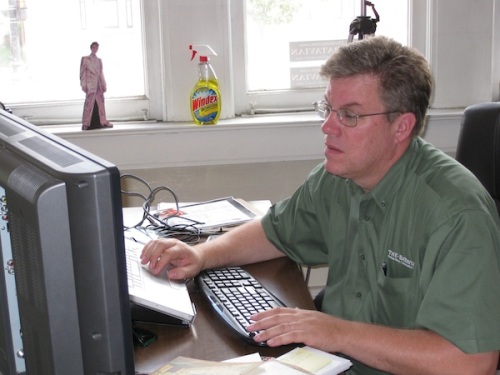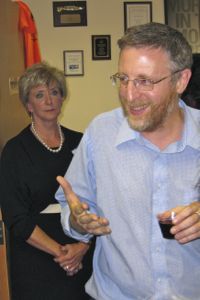 This article was previously published by the Nieman Journalism Lab.
This article was previously published by the Nieman Journalism Lab.
The New Haven Independent, which launched eight years ago amid the first wave of online-only community news sites, may soon expand into radio.
The nonprofit Independent is one of three groups asking the FCC for a low-power FM (LPFM) license in New Haven, Conn. If successful, editor and founder Paul Bass says that “New Haven Independent Radio” could make its debut at 103.5 FM in about a year.
“It would be a fun thing if we get it. I’m told it’s very hard,” Bass says. “We’re by no means talking as if we’re going to get this license. We thought it would be worth a shot.” He envisions a mix of news from the Independent and La Voz Hispana de Connecticut, the Independent’s content partner (and landlord), as well as music, public affairs, and shows produced by local nonprofit organizations. The station would be on the air at least 16 hours a day.
The three New Haven applications are part of the FCC’s great LPFM land rush. Legislation signed by President Obama in 2011 eased restrictions on low-power stations, and the FCC is expected to approve about 1,000 applications sometime in 2014. More than 2,800 applications were received by the deadlinelast month, according to the website Radio World. (Thanks to Aaron Read of Rhode Island Public Radio for tipping me off about the Independent’s application.)
According to the Prometheus Radio Project, a longtime advocate of expanded community radio, “the over 800 low-power stations currently on the air are run by nonprofits, colleges, churches and emergency responders.” For years, the radio industry and (believe it or not) NPR fought the expansion of LPFM, arguing that new stations would interfere with established broadcast frequencies — a concern that advocates say is unwarranted.
Like all LPFM stations, New Haven Independent Radio’s broadcast footprint wouldn’t extend much beyond the city limits, although it would stream online as well — which could be significant, Bass says, given predictions that most cars will have streaming Internet radio within a few years.
Inspired by Haverhill
Bass says he got the idea from WHAV Radio in Haverhill, Mass., a nonprofit online community station (it also has a weak AM signal) whose volunteer general manager, Tim Coco, is seeking to expand with an LPFM license of his own. (I wrote about Coco’s radio ambitions last summer.) Coco, who runs an advertising agency and is a local politico of some note, is also among a group of residents working to launch a cooperatively owned community news site to be called Haverhill Matters, under the auspices of the Banyan Project.
“I’m happy I provided some inspiration,” Coco told me by email. “I believe the more local voices, the better for the community.”
Although Bass, if he is successful, may be the first hyperlocal news-site operator to start an independent radio station, the connection between the two media is a natural one. For instance, Howard Owens, publisher of The Batavian, a for-profit site that covers Genesee County in western New York, has partnered since 2009 with WBTA, an AM station with a strong community presence. An even more ambitious project is under way in the heart of the country, as the St. Louis Beacon news site is merging with St. Louis Public Radio.
Donna Halper, a longtime radio consultant and historian who is an associate professor of communication at Lesley University, says a multiplatform presence of the sort Bass envisions is crucial at a time when the audience has become fragmented.
“These days, it’s a multimedia world, and even a low-power FM station can get people talking” about your work, she says. “In this kind of environment, the more platforms you are on, the more you have top-of-the-mind awareness.”
On the other hand, industry observer Scott Fybush, who writes about radio for his own eponymous website, warns that Bass may not quite realize what he is getting into.
“Twenty-four hours a day of radio is an unforgiving taskmaster,” Fybush said in an email. “There are lots of applicants in this LPFM window who have what appear to be noble ideas, but keeping a station going with engaging programming day in and day out isn’t easy to do.”
Three-way contest
But that’s getting ahead of things, because first Bass has to win the three-way contest for the New Haven license. And that is by no means assured. (Bass’s application was filed by the Online Journalism Project, the nonprofit entity that acts as the Independent’s publisher of record.)
According to documents on file with the FCC, the other two applicants are a Spanish-language organization and a Christian broadcaster called Alma Radio. Even though LPFM is intended to encourage localism, Alma proposes to broadcast nationally syndicated religious programs, including “Focus on the Family,” hosted by the controversial evangelical leader James Dobson. Alma Radio’s oversight board, according to a “Purposes and Objectives” document it included with its application, is “composed of members who believe and have a personal relationship with Jesus Christ.”
Although Bass says his ideas for the station are still evolving, he included a detailed proposal with his FCC application, with such diverse offerings as a morning news program; a daily “La Voz Latino Community Hour”; a collaboration with The Inner-City News, a local African-American publication; community theater; and a two-hour evening program to be called “Joe Ugly Presents Local Hip Hop.” (Joe Ugly is the nom de rap of a New Haven music impresario who runs an Internet radio station called Ugly Radio.)
One of the New Haven Independent’s funders has already put up $3,000, which paid for legal and engineering services. If Bass wins the license, he estimates it would cost $30,000 to build the station and $60,000 to $70,000 to pay a full-time employee to run it — a substantial amount over the approximately $500,000 a year the Independent now receives in donations, foundation grants, and corporate sponsorships.
The opportunity is clear enough. Done right, it would enable Bass to bring New Haven Independent journalism, with its hyperlocal emphasis on neighborhoods, schools, and city politics, to a new audience — and to entice that audience, in turn, into sampling the Independent.
The danger, of course, is that the radio project would drain resources and attention away from the Independent itself, diluting its mission with a gamble on a new platform that may or may not succeed. Bass’s answer to that challenge is simple and direct: “We have to make sure it doesn’t.”
Photo (cc) by Michael Coughlan and published under a Creative Commons license. Some rights reserved.





 A malicious computer virus known as “Darkleech,” which has hit
A malicious computer virus known as “Darkleech,” which has hit